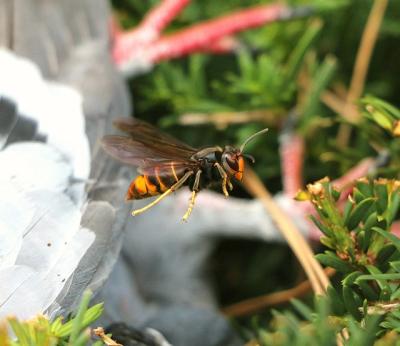Asian hornets, Vespa velutina, are back in the news. So far this year, newspapers have reported sightings in Northumberland, Dorset and Kent and, after a recent Pest Control Education and Training Forum meeting, our Technical Manager Chris Davis told us hornet queens had also been spotted in Hampshire.
The problem is this could be just the tip of the iceberg and they could turn up anywhere.
Where do Asian hornets come from?
As the name would suggest Asia or, more specifically, the border area between Northern India and China, the Indo-Chinese peninsula and the Indonesian archipelago. It is believed they first arrived in France in 2004 after hitching a ride on flowerpots exported from China. From there, they spread rapidly, with the first sightings in the UK in 2016 (Tetbury, Gloucestershire).
This invasive species is already a major problem in the Channel Islands, where a ‘crack squad’ of volunteers led by an ex-police detective, destroyed 174 nests in 2022. So far though, the English Channel has slowed down their advance on to the mainland with only sporadic sightings being reported. There are, however, many other ways they could accidentally be introduced – cut flowers, freight containers, untreated timber, in the soil around plants, etc.
What’s the threat?
Asian hornets or, to give them a preferable name, the yellow-legged hornet, are highly aggressive. They are predators of pollinators such as bees. Across Europe, they have already destroyed many bee communities which has a major impact on our ecosystem.
The problem for our native species is that they have not developed a defence against the yellow-legged hornet. This isn’t the case in Asia, where local bee populations have developed a way to defend their nests by surrounding the hornet and then cooking them alive. I recommend watching this BBC Earth footage, it’s quite impressive.
Identifying an Asian hornet
The Asian hornet looks very different to our native European hornet. They are shorter, have different colouring and are never active at night.
I’ve created this guide to help you spot the difference.
Asian (A) hornet vs European (E) hornet
Length: queens (A) up to 30mm, (E) up to 35mm; workers (A) up to 25mm, (E) up to 30mm
Legs: (A) yellow at the end, (E) brown at the end
Abdomen: (A) dark brown/black with yellow/orange band on fourth segment, (E) yellow with brown on the upper part, no banding
Head: (A) dark from above, orange from front, (E) yellow from above and front
Antennae: (A) dark, (E) yellow
Thorax: (A) entirely black and velvety, (E) black with extensive brown markings
If I spot one, what should I do?
Report it!
This is an Alert Species and should immediately be reported to the Non-native Species Secretariat by clicking here.
And don’t be tempted to try to deal with a yellow-legged hornet yourself. For one thing, they are aggressive and can sting you multiple times. The sting has been described as being similar to a red-hot needle. Secondly, the key is to find the nest, so that it can be destroyed. Reporting any sightings and then letting the experts deal with it, is the best way.
Read our hornet page to learn more.
Image by haim charbit from Pixabay
